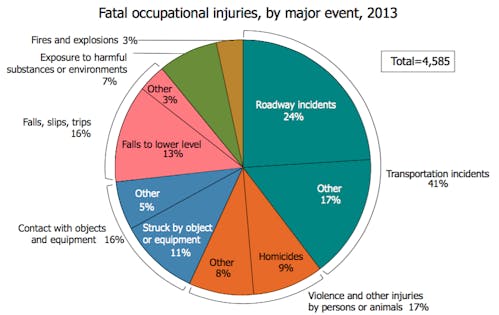Two television journalists were shot to death in Moneta, Virginia, during a live broadcast on Wednesday morning. Reporter Alison Parker and cameraman Adam Ward were taping a live interview for WDBJ, the Roanoke affiliate of CBS. Before he was shot, Ward captured an image of the gunman, identified as Vester Flanagan, a former WDBJ reporter who used the on-air name Bryce Williams. He reportedly shot himself in the head during a police chase and later died.

Shortly after the shooting, Flanagan went on Twitter to take credit for the shooting and express grievances against Parker and Ward. He then posted two videos that showed someone walking up to the crew and then pointing a gun at Parker and firing. (Twitter suspended the account shortly after the videos were posted.)
Workplace murder is relatively rare in the U.S. In 2013, the most recent year for which the Bureau of Labor Statistics has released data, there were 4,5851 total fatal injuries, including 404 workplace homicides. Of those, 322 were listed as “shooting by other person—intentional.” While women are less likely to die on the job, a higher percentage of them die by homicide compared to men: According to a preliminary news release on the 2013 data from the BLS, “Of the 302 fatal work injuries involving female workers, 22 percent involved homicides, compared to 8 percent for men.”2 Yet workplace homicide rates for men are still high. In 2013, 66 women were murdered on the job, and 338 men were. Recent years have been higher: In 2012, 99 women and 376 men were victims of workplace homicide, and in 2011, 78 women and 390 men died this way.


"[C]ontrary to popular opinion, sensational multiple homicides represent a very small number of workplace violence incidents," states a 2002 FBI report on workplace violence. "The majority of incidents that employees/managers have to deal with on a daily basis are lesser cases of assaults, domestic violence, stalking, threats, harassment (to include sexual harassment), and physical and/or emotional abuse that make no headlines. Many of these incidents, in fact, are not even reported to company officials, let alone to police." Risk factors include "personality conflicts (between coworkers or between worker and supervisor); a mishandled termination or other disciplinary action; bringing weapons onto a work site; drug or alcohol use on the job; or a grudge over a real or imagined grievance. Risks can also stem from an employee’s personal circumstances—breakup of a marriage or romantic relationship; other family conflicts; financial or legal problems; or emotional disturbance."
The most recent reports from Virginia indicate that Flanagan did display behaviors that could have been interpreted as indicating his risk for violent behavior. WDBJ general manager Jeff Marks described Flanagan as “being difficult to work with” and “a very unhappy man.” Flanagan was fired “after many incidents of his anger," Marks stated on air. "He did not take that well, we had to call police to escort him from the building.” Marks added that while Flanagan alleged that some coworkers made “racial comments,” “none of them could be corroborated by anyone. We think they were fabricated.”
When the data is broken down by gender in the report, it provides a total of 4,584 fatal workplace injuries, but the overall total is listed as 4,585.
The news release came out in September 2014, but the 2013 data was updated earlier this year, so some numbers are slightly different between the two reports.
